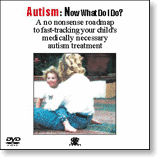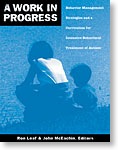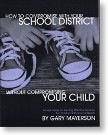We're Aware Already: Part Two
What Autism Awareness Should be About
Written by: David Celiberti, Ph.D., BCBA, President, Association for Science in Autism Treatment
Autism Awareness Month has come to a close. The blue puzzle pieces will soon disappear from Facebook pages and billboards, the media will focus their attention to other topics of interest, and we will return to business as usual. And business as usual is not OK.
When I first entered the field over twenty years ago, autism was considered a rare condition. When people asked what I did for a living, they often misheard me and thought I worked with "artistic" children. Today, autism is no longer the rare diagnosis that impacts someone else's child. Our extended families, our neighbors, and our co-workers are now all touched by autism. With 1 in 110 children receiving a diagnosis, the sheer number of individuals with autism heightens awareness in and of itself.
For many conditions, awareness is key because awareness promotes detection, and with detection comes a relatively clear path towards treatment. Take, for example, Lyme disease and many forms of cancer. Better prognoses are attached to early detection. Within a few short weeks of detection and diagnosis, patients typically receive science-based treatment. If their conditions are not detected early, then access to such treatments is delayed and their conditions will likely worsen.
In the world of autism, detection is not the "be all and end all." We do not just have a detection issue in autism, but also(and perhaps more importantly) we have an intervention issue. It is my hope that the conversation about autism awareness will be broadened to focus upon the obstacles that separate individuals with autism from effective, science-based intervention and that those that separate their families, caregivers, and teachers from accurate information about autism intervention.
I leave you with 10 ideas about what "autism awareness"should be about.
- "Autism Awareness" should recognize the need to differentiate effective treatments that are scientifically validated from the plethora of "therapies" and "cures" lacking scientific support. Autism treatment has become a multi-million dollar industry with 400+ alleged treatments and thus, science sadly placed on the back burner. This means that heart wrenching testimonials, surveys that are pawned off as scientific research, and outrageous claims abound, making it challenging for parents to determine the best course of action for their child. The aggressive marketing of these "therapies" and "cures" is absolutely overwhelming for parents who are desperate for accurate information to help their children realize their fullest potential. For most other medical conditions, a provider that disregards proven intervention and uses a fringe treatment may actually be sued for malpractice. Such safeguards do not yet exist for autism. Please see our treatment summaries for information about the presence or absence of scientific support for scores of autism treatments at: http://asatonline.org/intervention/autismtreatments.htm
- "Autism Awareness" must recognize the responsibility that we have as a society to make sound choices. I use the term "society" given the myriad stakeholders who make critically important decisions for persons with autism - not just parents, but siblings, teachers, treatment providers, administrators, program coordinators, and tax payers. Decision-making power comes with tremendous responsibility. There are far too many individuals with autism who are not receiving effective treatment, are receiving ineffective treatment, or are subjected to treatments that are, in fact, dangerous. Every minute of ineffective intervention is one less minute spent accessing effective intervention.Every dollar spent on an intervention that does not work depletes resources available for intervention thatdoes work. Please see the questions that appear at the end of this article to promote more careful decision making at http://www.researchautism.org/uploads/roadless.pdf
- "Autism Awareness" must recognize that available information (and information providers) varies greatly in accuracy. As we know, not all information on the Internet is reliable and accurate. Often Internet information is deemed equivalent in relevance, importance, and validity to research published in peer-reviewed scientific journals. In fact, it is not.
- "Autism Awareness" must include careful and responsible reporting by journalists who fully embrace their role as "public educators" and are committed to the dissemination of accurate information. There are dozens of "miracle cures" and "breakthroughs" for autism that receive widespread media attention, even if they have not been proven effective. Unfortunately, treatments actually shown to be effective typically receive the least amount of media attention. It is hard to imagine that things will improve dramatically for the autism community in the absence of more accurate representations of autism treatment in the media. You will find examples of accurate and inaccurate reporting here http://asatonline.org/media_watches. ASAT is also undertaking some proactive steps to enhance accuracy in media reporting.
- "Autism Awareness" should recognize the critical need for newly diagnosed children to access effective treatment as soon as possible. We know that early intervention can make a huge difference. We also know that we have a limited window of time to prepare children for the least restrictive setting once they enter public school. The fact that resources allocated early can save a tremendous amount of resources over an individual’s lifespan does not always enter the conversation when evaluating costs and benefits. That must change.
- "Autism Awareness" should also instill hope for a better tomorrow for those individuals who are not part of the "best outcome" group. With the right treatment, individuals with autism can lead happy and fulfilling lives. Research indicates that interventions such as applied behavior analysis (ABA) can effectively help children and adults with autism realize their fullest potential. The conversation about "cure" often delegitimizes and derails important conversations about how we can help individuals with autism live and work independently, develop meaningful relationships, reduce challenging behaviors that may limit opportunities, access faith communities, and enjoy the array of recreational pursuits that are available within their communities. Those are important conversations to be had.
- "Autism Awareness" must mandate accountability from all treatment providers. Accountability involves a shared commitment to data collection, objectively defined targets, and respect for the scientific method. It is every provider’s responsibility to objectively measure outcomes regardless of their discipline. No one should get a pass on accountability. No one is immune from defining their target and objectively measuring progress. No one should be permitted to boast claims that they cannot demonstrate through data. In fact, one could argue that providers using interventions that lack scientific support have an ethical obligation to share this fact with their consumers and to exercise even greater caution in predicting and measuring outcomes. Far too often, applications of interventions that lack any scientific support are carried out in a manner divorced from any semblance of objective measurement. That should not be tolerated.
- "Autism Awareness" must involve recognition that an abundance of clinical research already exists. Too often, the plethora of peer-reviewed research that could guide and inform treatment efforts is disregarded or ignored altogether. If treatment providers and consumers are interested in published research on diverse topics such as improving conversation skills, promoting academic skills, eliminating pica, or developing tolerance for dental procedures, they can find it. Thousands of researchers have worked hard at publishing their findings in peer reviewed journals and their findings are often overshadowed by a media that practices sensationalism to provide consumers with information about the "next big thing" in autism treatment.
- "Autism Awareness" should help us identify and overcome the barriers that face our families everyday. Not every child with autism is invited to birthday parties. Not every faith community welcomes families of children with autism. Not every school provides meaningful contact between students with autism and their typically developing peers. Not every community provides recreational opportunities for individuals with autism. The absence of these opportunities is both a function of misinformation about autism and lack of awareness about the successful efforts of others who have overcome such barriers. With 1 in 110 children being diagnosed, every facet of society would benefit from evaluating what they are doing, what they are not doing, and what they could be doing differently
- "Autism Awareness" should be about the reality that the hundreds of thousands of children with autism will soon become hundreds of thousands of young adults with autism. We are facing a crisis in the field with a scarcity of services for adults with autism and the absence of a clear strategy for closing the gap between the ever increasing need and an unprepared supply of resources. It was recently brought to our attention that our website and newsletter did not represent lifespan issues. Starting with this issue of Science in Autism Treatment and moving forward, we are committing to broadening our scope so we are part of an important dialogue about adults with autism.












